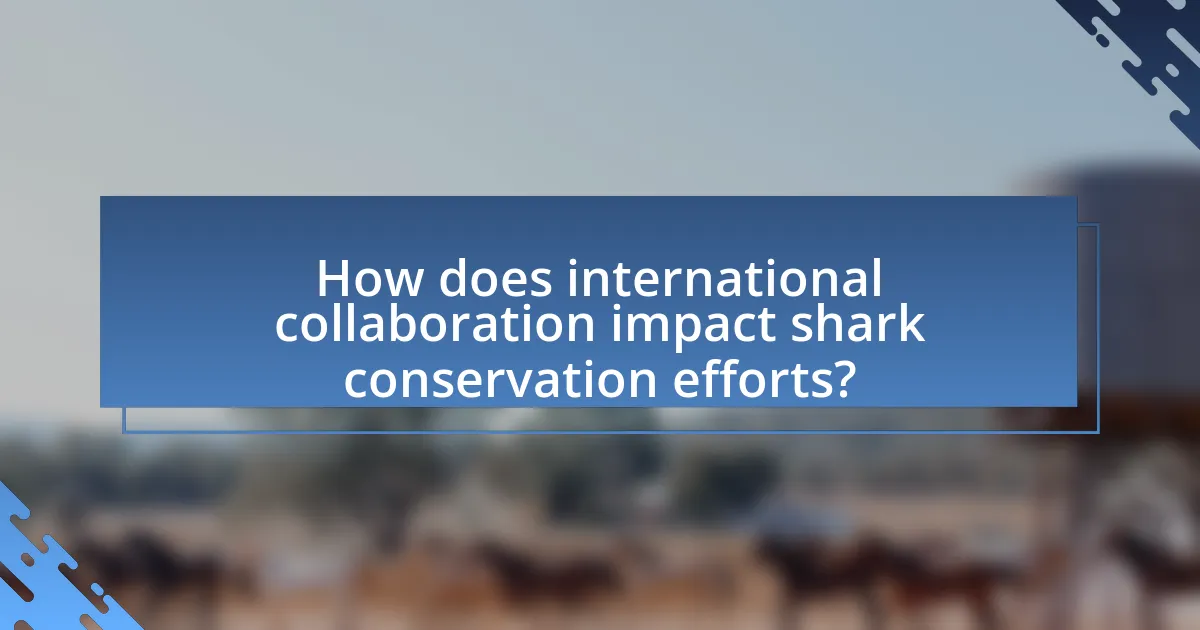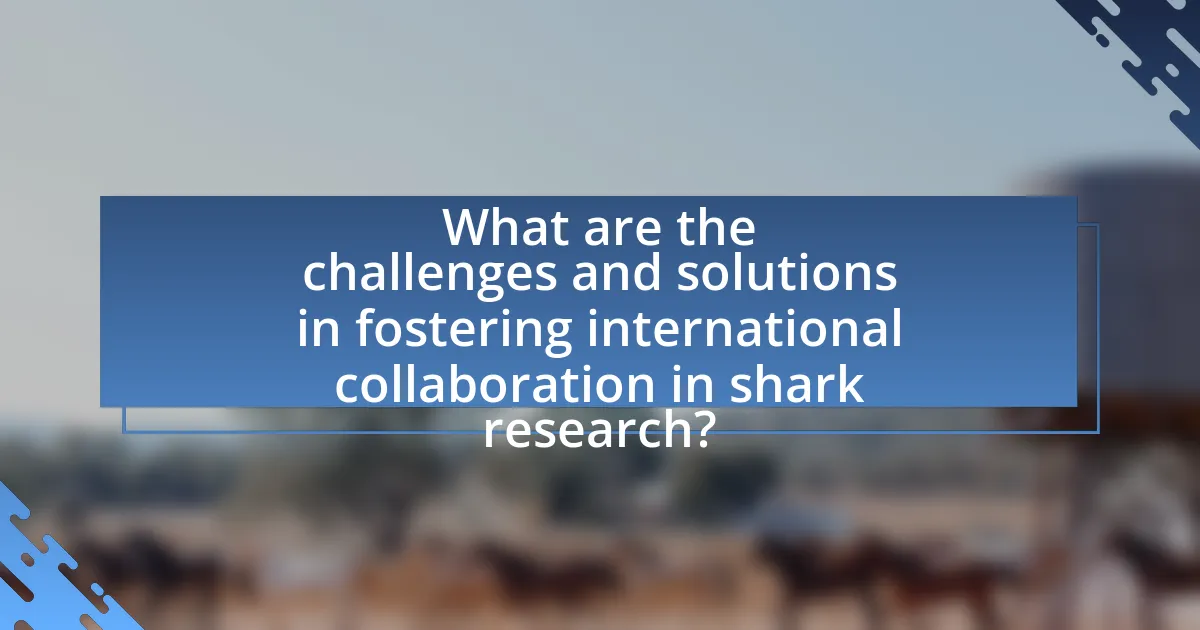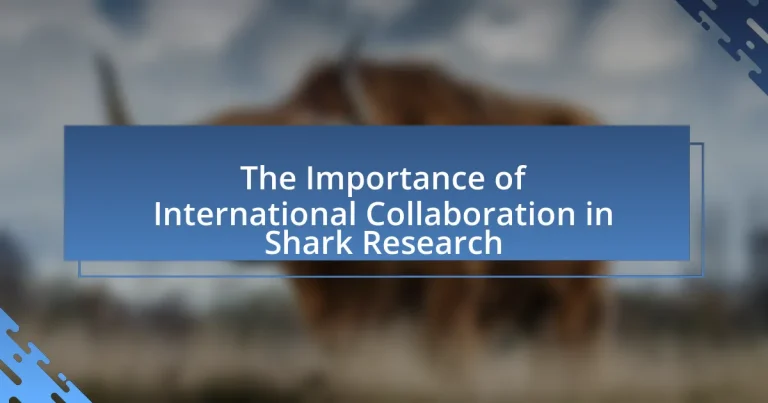The article emphasizes the critical role of international collaboration in shark research, highlighting its necessity for effective conservation and management of shark populations that migrate across international waters. It discusses how collaborative efforts, such as the Global Shark Movement Project, enhance data sharing, resource pooling, and the understanding of shark behavior and population dynamics. The article also addresses the challenges researchers face without collaboration, including limited data access and funding disparities, while outlining the benefits of joint initiatives in improving conservation strategies and influencing global policy-making for shark protection. Additionally, it explores practical steps and best practices for fostering successful international partnerships in shark research.

What is the Importance of International Collaboration in Shark Research?
International collaboration in shark research is crucial for effective conservation and management of shark populations globally. Sharks migrate across international waters, making it essential for researchers from different countries to share data, methodologies, and findings to understand their behavior, population dynamics, and threats. Collaborative efforts, such as the Global Shark Movement Project, have demonstrated that pooling resources and expertise leads to more comprehensive studies, enabling scientists to track shark movements and assess their ecological roles more accurately. This collective approach enhances the ability to implement effective conservation strategies, as evidenced by the increased protection measures adopted in regions where international research partnerships have been established.
Why is international collaboration crucial for shark research?
International collaboration is crucial for shark research because sharks migrate across international waters, making it essential for scientists from different countries to work together to gather comprehensive data. Collaborative efforts enable the sharing of resources, expertise, and technology, which enhances the understanding of shark behavior, population dynamics, and conservation needs. For instance, the Global Shark Tracker project, which involves multiple countries, utilizes satellite technology to monitor shark movements, providing valuable insights that individual nations could not achieve alone. This collective approach is vital for effective management and protection of shark species, as evidenced by the International Union for Conservation of Nature’s recognition of the need for transboundary conservation strategies.
What challenges do researchers face without international collaboration?
Researchers face significant challenges without international collaboration, including limited access to diverse data sets and restricted sharing of expertise. The lack of collaboration hinders the ability to conduct comprehensive studies that require a global perspective, particularly in fields like shark research where species migrate across international waters. Additionally, researchers may struggle with insufficient funding and resources, as collaborative projects often attract more financial support and shared infrastructure. A study published in the journal “Nature” highlights that international partnerships can enhance research quality and innovation, demonstrating that collaborative efforts lead to more impactful findings and advancements in understanding complex ecological issues.
How does collaboration enhance data sharing among researchers?
Collaboration enhances data sharing among researchers by fostering a collective environment where knowledge, resources, and findings are openly exchanged. When researchers work together, they can pool their data sets, which increases the volume and diversity of information available for analysis. For instance, a study published in the journal “Nature” highlighted that collaborative projects often lead to the creation of shared databases, allowing researchers to access a wider range of data than they would individually. This shared access not only accelerates the pace of research but also improves the quality of findings by integrating multiple perspectives and expertise.
What are the key benefits of international collaboration in shark research?
International collaboration in shark research enhances data sharing, resource pooling, and comprehensive understanding of shark populations across different regions. By working together, researchers can access a wider range of data, leading to more robust findings and improved conservation strategies. For instance, the Global Shark Tracker initiative, which involves multiple countries, allows scientists to monitor shark movements and behaviors globally, providing critical insights into their migratory patterns and habitat use. This collaborative approach not only strengthens scientific knowledge but also fosters unified conservation efforts, as seen in the joint management of migratory shark species under international agreements like the Convention on Migratory Species.
How does collaboration improve the quality of research findings?
Collaboration improves the quality of research findings by integrating diverse expertise and perspectives, which enhances the robustness of the research process. When researchers from different disciplines and geographical locations work together, they can address complex questions more effectively, leading to more comprehensive and reliable results. For instance, a study published in the journal “Nature” highlighted that interdisciplinary collaboration in marine biology, including shark research, resulted in innovative methodologies and improved data accuracy, ultimately leading to better conservation strategies. This evidence demonstrates that collaborative efforts not only enrich the research but also contribute to more impactful outcomes in the field.
What role does international collaboration play in conservation efforts?
International collaboration plays a crucial role in conservation efforts by enabling countries to share resources, knowledge, and strategies to protect biodiversity effectively. For instance, collaborative initiatives like the Convention on International Trade in Endangered Species (CITES) facilitate coordinated actions among nations to regulate trade and protect endangered species, including sharks. Such partnerships enhance research capabilities, as seen in the Global Shark Movement Project, which involves multiple countries working together to track shark populations and migration patterns. This collective approach leads to more comprehensive data collection and informed decision-making, ultimately improving conservation outcomes.

How does international collaboration impact shark conservation efforts?
International collaboration significantly enhances shark conservation efforts by facilitating the sharing of data, resources, and best practices among countries. This cooperative approach allows nations to address the transboundary nature of shark populations and the threats they face, such as overfishing and habitat loss. For instance, the Convention on International Trade in Endangered Species of Wild Fauna and Flora (CITES) has enabled countries to work together to regulate the trade of shark species, leading to improved protection measures. Additionally, collaborative research initiatives, such as the Global Shark Trends Project, have provided critical insights into shark population dynamics and conservation needs, demonstrating that unified efforts yield more effective strategies for preserving these vital marine species.
What specific conservation projects benefit from international collaboration?
Specific conservation projects that benefit from international collaboration include the Global Shark Movement Project and the Shark Research and Conservation Program. The Global Shark Movement Project involves multiple countries working together to track shark migrations and assess population dynamics, utilizing satellite tagging and data sharing to enhance conservation efforts. The Shark Research and Conservation Program focuses on collaborative research initiatives that engage scientists, policymakers, and local communities across various regions to develop effective management strategies for shark populations. These projects demonstrate the effectiveness of shared resources and knowledge in addressing the challenges of shark conservation on a global scale.
How do international partnerships facilitate funding for shark research?
International partnerships facilitate funding for shark research by pooling resources, expertise, and funding opportunities from multiple countries and organizations. These collaborations often lead to joint grant applications, which can increase the likelihood of securing larger amounts of funding due to the combined credibility and reach of the partners involved. For instance, initiatives like the Global Shark Conservation Initiative have successfully garnered financial support from various international bodies, demonstrating how collaborative efforts can attract diverse funding sources. Additionally, shared data and research findings from international partnerships enhance the scientific validity of projects, making them more appealing to potential funders.
What are the outcomes of successful international conservation initiatives?
Successful international conservation initiatives lead to the preservation of biodiversity, restoration of ecosystems, and sustainable management of natural resources. For instance, the Convention on International Trade in Endangered Species (CITES) has successfully regulated trade in over 35,000 species, contributing to the recovery of endangered species populations. Additionally, the establishment of marine protected areas (MPAs) through collaborative efforts has resulted in increased fish biomass and improved resilience of marine ecosystems, as evidenced by studies showing that MPAs can lead to a 20-50% increase in fish populations within their boundaries. These outcomes demonstrate the effectiveness of international cooperation in achieving conservation goals.
How does international collaboration influence policy-making for shark protection?
International collaboration significantly enhances policy-making for shark protection by facilitating the sharing of scientific data, resources, and best practices among countries. This cooperation allows nations to develop comprehensive conservation strategies that address the global nature of shark populations and threats, such as overfishing and habitat loss. For instance, agreements like the Convention on International Trade in Endangered Species (CITES) and the Memorandum of Understanding on the Conservation of Migratory Sharks promote coordinated efforts to regulate trade and protect migratory shark species across borders. Such collaborative frameworks ensure that policies are informed by a broader understanding of ecological dynamics and are more effective in safeguarding shark populations worldwide.
What role do international agreements play in shark conservation?
International agreements play a crucial role in shark conservation by establishing frameworks for cooperation among countries to protect shark populations and their habitats. These agreements, such as the Convention on International Trade in Endangered Species of Wild Fauna and Flora (CITES) and the Convention on Migratory Species (CMS), facilitate the regulation of trade and promote the sustainable management of shark species. For instance, CITES lists several shark species under its appendices, which restricts international trade to prevent overexploitation. Additionally, the CMS encourages countries to collaborate on migratory species, ensuring that conservation efforts are coordinated across borders. Such international cooperation is essential, as many shark species migrate across vast oceanic distances, making unilateral national efforts insufficient for effective conservation.
How can researchers influence global policies through collaboration?
Researchers can influence global policies through collaboration by sharing data, expertise, and resources to create a unified approach to pressing issues. Collaborative efforts, such as international research networks, enable researchers to present comprehensive findings that inform policymakers about the importance of conservation measures. For instance, the Global Shark Conservation Initiative, which involves multiple countries and institutions, has successfully advocated for stronger protections for shark species by providing evidence-based recommendations to international governing bodies like the Convention on International Trade in Endangered Species (CITES). This collaborative framework not only enhances the credibility of research but also amplifies the impact of scientific findings on policy decisions.

What are the challenges and solutions in fostering international collaboration in shark research?
The challenges in fostering international collaboration in shark research include differing regulatory frameworks, funding disparities, and varying research priorities among countries. These differences can hinder data sharing and joint initiatives, as countries may have conflicting interests or lack the resources to participate fully. Solutions to these challenges involve establishing standardized protocols for data sharing, creating international funding mechanisms to support collaborative projects, and fostering partnerships through workshops and conferences that align research goals across nations. For instance, the Global Shark Conservation Initiative has successfully brought together researchers from multiple countries to address these issues by promoting shared objectives and resources.
What barriers exist to effective international collaboration in shark research?
Barriers to effective international collaboration in shark research include differing national regulations, lack of funding, and insufficient data sharing. National regulations can vary significantly, leading to challenges in standardizing research methodologies and conservation efforts across borders. For instance, countries may have different fishing quotas or protection statuses for shark species, complicating collaborative studies. Additionally, funding disparities often hinder joint projects, as some nations may lack the financial resources to participate fully in international initiatives. Lastly, insufficient data sharing among countries limits the ability to conduct comprehensive assessments of shark populations and their habitats, which is crucial for effective conservation strategies.
How can language and cultural differences impact collaboration?
Language and cultural differences can significantly impact collaboration by creating barriers to effective communication and mutual understanding. When team members speak different languages, misinterpretations can occur, leading to confusion and errors in project execution. For instance, a study published in the Journal of International Business Studies found that language barriers can reduce team performance by up to 30%. Additionally, cultural differences can influence work styles, decision-making processes, and conflict resolution approaches, which may result in misunderstandings or conflicts among team members. Research by Hofstede Insights highlights that varying cultural dimensions, such as individualism versus collectivism, can affect how teams collaborate and share information. Therefore, recognizing and addressing these differences is crucial for fostering successful international collaboration in shark research and other fields.
What logistical challenges do researchers face when collaborating internationally?
Researchers face several logistical challenges when collaborating internationally, including differences in time zones, communication barriers, and varying regulatory requirements. Time zone discrepancies can hinder real-time communication and coordination, making it difficult to schedule meetings and share information promptly. Communication barriers, such as language differences, can lead to misunderstandings and misinterpretations of research objectives and methodologies. Additionally, varying regulatory requirements across countries can complicate the approval processes for research permits, ethical reviews, and data sharing agreements, potentially delaying project timelines. These challenges can significantly impact the efficiency and effectiveness of international research collaborations.
What strategies can enhance international collaboration in shark research?
Enhancing international collaboration in shark research can be achieved through the establishment of standardized data-sharing platforms. These platforms facilitate the exchange of research findings, methodologies, and conservation strategies among scientists globally. For instance, the Global Shark Tracker initiative allows researchers to share tracking data in real-time, promoting collaborative studies on shark migration patterns and population dynamics. Additionally, fostering partnerships between academic institutions and conservation organizations across different countries can lead to joint research projects, pooling resources and expertise. Collaborative funding opportunities, such as those provided by the Shark Conservation Fund, enable researchers from various nations to work together on critical issues affecting shark populations. These strategies collectively strengthen the global effort to understand and protect shark species effectively.
How can technology facilitate better communication among researchers?
Technology facilitates better communication among researchers by providing platforms for real-time collaboration and data sharing. Tools such as video conferencing, collaborative software, and online databases enable researchers to connect across geographical boundaries, enhancing the exchange of ideas and findings. For instance, platforms like Zoom and Microsoft Teams allow for virtual meetings, while tools like Google Drive and GitHub support collaborative document editing and code sharing. According to a study published in the journal “PLOS ONE,” effective use of technology in research collaboration can lead to increased productivity and innovation, demonstrating that technology is essential for fostering international collaboration in fields such as shark research.
What best practices should researchers adopt for successful collaboration?
Researchers should adopt clear communication, defined roles, and mutual respect as best practices for successful collaboration. Clear communication ensures that all team members understand objectives, methodologies, and expectations, which is crucial in complex fields like shark research where interdisciplinary knowledge is often required. Defined roles help to streamline efforts and prevent overlap, allowing researchers to leverage each other’s strengths effectively. Mutual respect fosters a positive working environment, encouraging diverse perspectives and innovative solutions. These practices are supported by studies indicating that effective collaboration enhances research outcomes, as seen in the collaborative efforts of international shark research initiatives that have led to significant advancements in conservation strategies.
What practical steps can researchers take to engage in international collaboration?
Researchers can engage in international collaboration by establishing partnerships with foreign institutions, participating in global conferences, and utilizing online collaboration platforms. Establishing partnerships allows researchers to share resources, expertise, and data, which is crucial in fields like shark research where diverse ecosystems are involved. Participating in global conferences facilitates networking and the exchange of ideas, fostering collaborative projects. Utilizing online collaboration platforms, such as ResearchGate or GitHub, enables researchers to work together across borders, share findings, and co-author publications, thereby enhancing the collective understanding of shark conservation and management.


